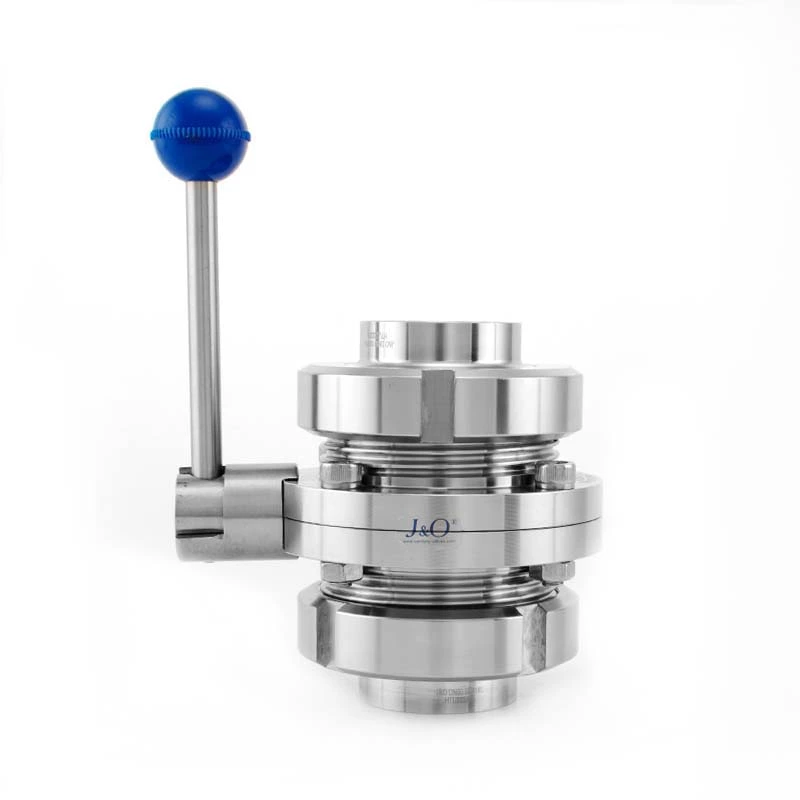How The Sanitary Butterfly Valve Works
Sanitary Butterfly Valve in a railway passenger train toilet is a key component for ensuring the tightness and control of the toilet's sewage system. This butterfly valve is typically installed between the toilet and the sewage pipe, opening and closing mechanically to control the discharge path of waste. To better understand its operation, we will discuss its structure, workflow, and maintenance strategies.
Structurally, the butterfly valve consists of four main components: the valve body, valve plate, seal, and actuator. The circular valve body is cast from stainless steel, with an inner diameter that perfectly matches the sewage pipe and a corrosion-resistant surface treatment. The valve plate is the core component, a metal disc shaped like a butterfly's wing, connected to the actuator via a central axis. The seal, typically made of acid- and alkali-resistant rubber, wraps around the edge of the valve plate to form an elastic seal. Depending on the vehicle model, the actuator is divided into two types: manual handle and pneumatic control. Newer trains generally use pneumatic actuation.
The entire operation revolves around the rotation of the valve plate. When the toilet flush button is triggered, the actuator rotates the valve plate 90 degrees, causing it to become parallel to the pipe, fully opening the sewage channel. Under the influence of gravity or negative pressure, waste rapidly passes through the valve and enters the storage tank. Once wastewater is discharged, the drive reverses, rotating the valve disc 90 degrees to its vertical position. The rubber seal seals tightly against the valve body, effectively preventing odor backflow and liquid leakage. Pneumatic butterfly valves rely on compressed air to drive the cylinder, achieving precise angle control through a linkage mechanism. The actuation time is typically kept within 1.5 seconds.
Sealing performance is a key indicator for evaluating butterfly valve quality. High-quality seals must withstand liquid environments with a pH of 3-11, withstand high-frequency opening and closing cycles exceeding 15 times per minute, and maintain elasticity within a temperature range of -40°C to 80°C. Field test data for a certain model of butterfly valve shows no leakage for 30 minutes at a pressure of 0.35 MPa, and a service life of up to 100,000 cycles. These data demonstrate that material selection and manufacturing processes directly impact valve reliability.
A three-level inspection system is required for routine maintenance. Crew members visually inspect the valve body surface daily for ice and deformation, and use an endoscope to inspect the seal wear monthly. Maintenance personnel use a dedicated leak detector to test the seals quarterly, focusing on the grease condition on the valve plate axis. Overhauls require complete disassembly, using an ultrasonic cleaner to remove deposits on the valve plate, and replacing seals that have reached the wear threshold. Statistics from a railway bureau show that after implementing three-level maintenance, the butterfly valve failure rate dropped from an average of 5.3% to 0.8% annually.
Common failures can be categorized as mechanical sticking and seal failure. When the valve opens and closes poorly, first check whether the actuating air pressure is stable within the range of 0.6-0.8 MPa, and then check for foreign objects lodged in the valve plate shaft. Seal failure is often caused by rubber aging or chemical corrosion. Analysis of one incident revealed that a passenger accidentally poured chlorine bleach, causing the seal to swell and deform. In this case, the restroom must be immediately shut down, the entire seal assembly replaced, and the pH level of the sewage pipe tested with pH test paper.
In terms of technical improvements, some rolling stock depots have begun trialing laser inspection equipment. This equipment generates a three-dimensional model of the valve plate through laser scanning without disassembling the valve, allowing precise calculation of seal surface wear. In conjunction with a big data platform, the system can predict the remaining service life and provide part replacement reminders two weeks in advance. Experimental data shows that predictive maintenance reduces single-valve maintenance costs by 42% and shortens troubleshooting time by 75%.
Environmental adaptability is a key design priority. For trains operating in cold regions, butterfly valves must be equipped with electric heating devices to prevent icing, and the sealing material must be low-temperature-resistant fluororubber. Vehicles operating on coastal routes must also be equipped with 316L stainless steel anti-salt spray coating. There have been cases of valve plates freezing due to condensation freezing; this issue was resolved by installing an insulation sleeve on the valve body and adding internal drainage holes.
Operating regulations emphasize handling special circumstances. When a train stops for more than four hours, crew members must activate the valve every two hours to prevent sticking. In extremely cold weather, valves must be manually operated 5-10 times before departure to verify their fluidity. During the Spring Festival travel rush, a train conductor discovered that a carriage had failed to flush three times in a row. He immediately activated the backup sewage channel and displayed a fault sign, preventing sewage overflow and affecting other passengers.
In terms of technological advancement, intelligent butterfly valves are currently under development. This new valve, equipped with a pressure sensor and IoT module, monitors the sealing status in real time and automatically adjusts the actuating air pressure to compensate for minor wear. Laboratory tests have shown that the intelligent system can reduce sudden failure rates by 90%, but it currently faces technical bottlenecks such as power supply stability and data transmission delays. It is expected to be installed on trains for trial use within three years.
These details demonstrate that the seemingly simple butterfly valve actually incorporates sophisticated design considerations. Only by understanding its structural characteristics, mastering key maintenance points, and anticipating operational risks can we ensure the reliability of railway passenger car sewage systems. Next time you take a train, pay attention to the sound of air flowing when the toilet flushes—that's the butterfly valve quietly performing its mission.
